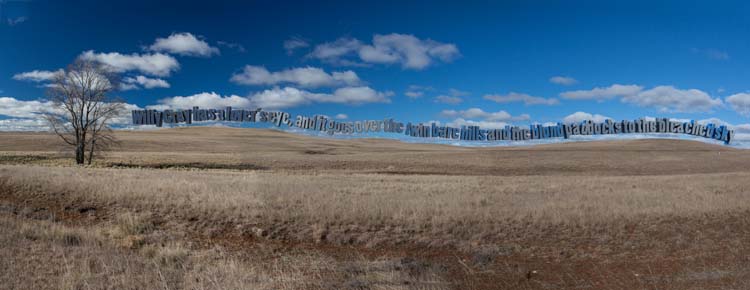
Willy Gray has a lover's eye, and it goes over the twin bare hills and the blond paddocks to the bleached sky
The text incorporated in this Monaro landscape image (three original photographs taken near Dalgety) is from The Monaro – a poem by David Campbell (reproduced in his Collected Poems). The full verse is:
“Willy Gray has a lover’s eye
and it goes over the twin bare hills
and the blond paddocks to the bleached sky
Until it has come to a thought that fills
his mind with tenderness for this wild
upland country and her suckling child”
The panoramic landscape image is a typical winter scene on the Monaro: Almost treeless, flat to undulating grassland terrain, suggesting human presence only through erosion scars. A long, almost uninterrupted horizon line and big skies. Sheep, dams, buildings, roads and fences are deliberately excluded, though in fact each of these was present just out of the frame. The intention is to present a ‘simple’ landscape, one which may bear close resemblance to the landscape as it was prior to European occupation.
The inclusion of the text floating above the horizon disrupts a straightforward reading of the scene. It informs the viewer that the creator of the image seeks to do something other than simply present a representation or bucolic idealisation of the scene. The viewer is compelled to ‘read’ (quite literally) the image, and to look for meaning or message within it.
In this particular image, the text is intended to function as an analogy for the way in which a European/Australian cultural narrative has been overlaid on the pre-existing, elemental landscape. Not part of the physical landscape, but projected onto it. A landscape and climate which is often difficult for its human inhabitants is described in terms of “tenderness” and viewed with “a lover’s eye”. It is anthropomorphised, given human attributes by the poet – and by those who share his vision. A maternal, nurturing character is projected onto land which (in truth) has no opinion or emotional character – other than that which we project onto it ourselves.
Implicit in this projection of language and character onto the landscape is the recognition that alternative narratives and visions, alternative personifications, will exist, alongside and in competition with the version presented in this image-text. I intend to explore some of these, and the competition between them, in other images.
